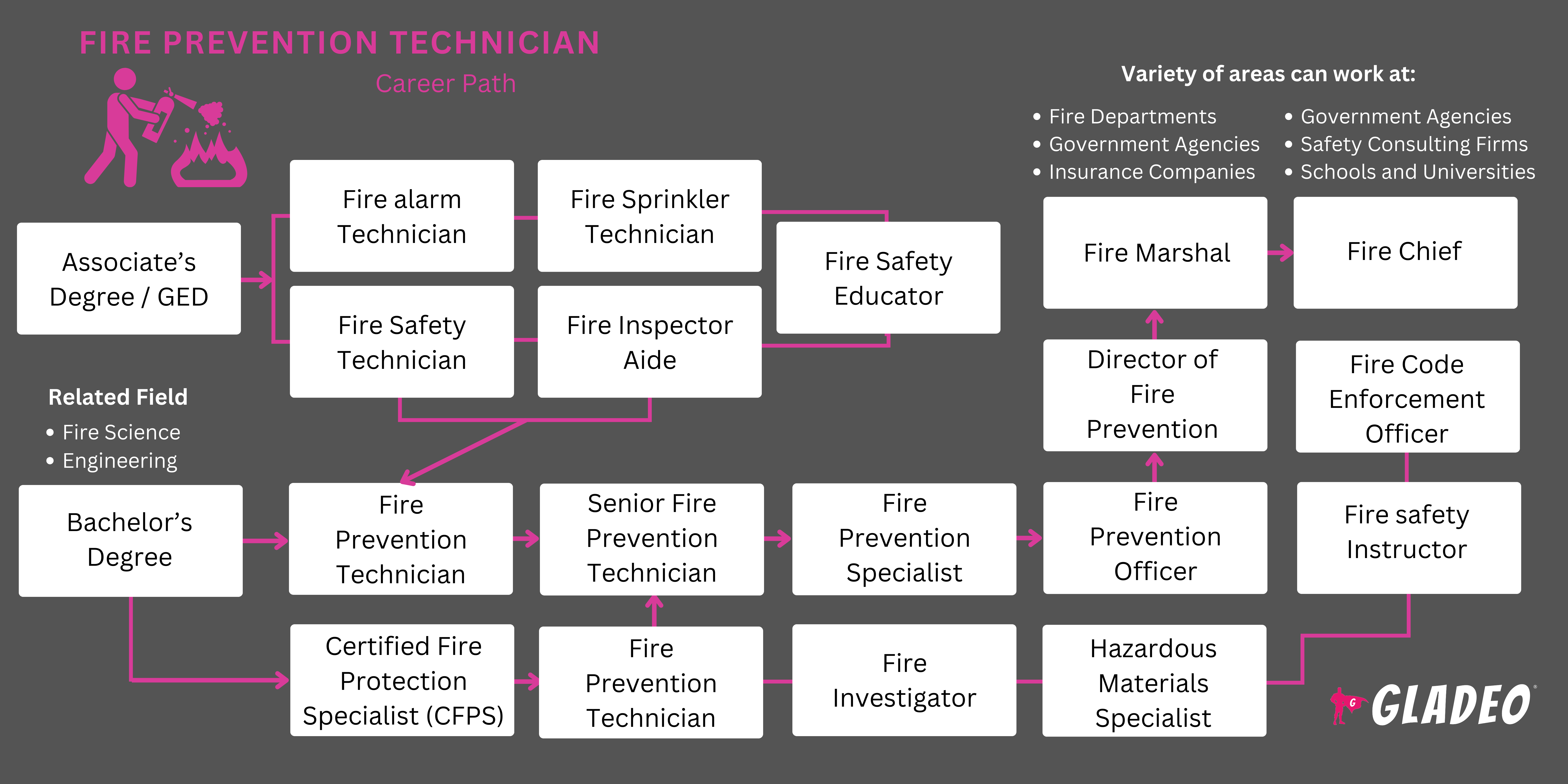Mga spotlight
Fire Inspector, Fire Safety Officer, Fire Marshal, Fire Protection Specialist, Fire Prevention Coordinator
If humans hadn’t figured out how to create and control fires, we’d still be living in the Stone Age. We would never have learned how to burn wood for heat and cooking. We also wouldn’t be able to burn coal to generate electricity or use fire to smelt metals.
But while fire is incredibly useful, it’s also one of the most destructive forces on Earth! It’s incredibly easy for unintentional fires to get started due to human negligence, overheated machinery, and faulty electrical wiring. That’s why many organizations utilize Fire Prevention Technicians to mitigate such potential hazards.
Unlike Fire Inspectors, technicians’ work is very hands-on. They typically focus on the technical aspects of fire prevention systems, including installation, maintenance, and repair of fire alarms, sprinklers, and fire safety-related electrical systems and mechanical components.
Note, there are also Fire Prevention Specialists who work with wildland firefighting crews.
- Helping to keep people and property safe from fires
- Potentially saving organizations from suffering serious losses
- Opportunities to work on a wide range of projects
Oras ng trabaho
- Fire Prevention Technicians typically work full-time, with frequent travel and overtime possible.
Mga Karaniwang Tungkulin
- Review existing fire prevention plans. Assess fire protection systems for compliance
- Advise on fire protection system design and installation
Install, test, and maintain fire alarms, sprinklers, and other fire suppression systems - Identify potential fire hazards in buildings and work environments
- Implement fire safety policies. Issue warnings and notices of correction
- Work with developers, architects, and engineers to ensure landscaping and vegetation are drought-tolerant or fire-resistant
- Conduct fire safety inspections and risk assessments of buildings
- Assess the fire resistance of building materials
- Take photos and use measuring devices and hydrocarbon analyzers, as needed
- Inspect fire extinguishers and other firefighting equipment
- Monitor fire detection and suppression system performance
- Consult on the storage and handling of flammable materials
- Prepare emergency evacuation plans. Train occupants on fire safety practices
- Organize fire drills and simulations
- Coordinate with local fire departments and emergency services
- Update fire safety documentation and records
Karagdagang Pananagutan
- File fire permits and plans
- Participate in fire safety meetings, workshops, and training programs
- Respond to public inquiries about fire safety codes and standards
- Support public fire education sessions
- Liaise with insurance companies regarding fire safety issues
- Help to investigate fire incidents to determine their causes
- Recommend improvements to enhance fire safety
- Evaluate new technologies and methods for fire prevention and protection
Soft Skills
- Analitikal
- Nakatuon sa pagsunod
- Kritikal na pag-iisip
- Mabusisi pagdating sa detalye
- Pagsasarili
- Inisyatiba
- Integridad
- Mga kasanayan sa pagmamasid
- Mga kasanayan sa paglutas ng problema
- May kamalayan sa kaligtasan
- Mukhang makatarungan
- Stamina
- Pamamahala ng oras
Teknikal na kasanayan
- Emergency response planning, including evacuation/emergency protocols
- Knowledge of fire alarms, sprinkler systems, and fire extinguishers
- Fire risk assessments of buildings and environments
- Knowledge of fire science, fire behavior, and preventative measures
- Hazardous materials handling and storage
- Investigation of fire incidents
- Local, state, and federal building codes and standards compliance
- Life Safety Code
- Report writing and documentation of inspections, compliance activities, investigations, etc.
- Understanding architectural plans, electrical diagrams, and fire protection system schematics
- Kaangkupang pisikal
- Basic first aid and CPR certification
- Mga kumpanya sa konstruksyon
- Institusyong pang-edukasyon
- Fire departments
- Mga ahensya ng gobyerno
- Mga pasilidad sa pangangalagang pangkalusugan
- Hospitality and entertainment venues
- Industrial facilities
- Mga kompanya ng seguro
- Private fire safety consulting firms
- Real estate and property management companies
Fire Prevention Technicians have a responsibility to ensure buildings and surrounding areas are as safe as possible from fire risks. The job requires a deep understanding of fire safety regulations and fire protection systems, which entails keeping up with technological advancements and regulatory changes.
Technicians may work irregular hours, including nights and holidays, to perform inspections or respond to emergencies. The job can be physically demanding or involve navigating difficult environments and handling heavy equipment. There’s some personal risk when entering hazardous areas to conduct post-incident investigations.
Lastly, there’s always the possibility of witnessing the aftermath of devastating fires, which can be stressful. Despite the challenges, Fire Prevention Technicians take pride in protecting lives, property, and communities through their professional dedication and personal resilience!
There’s a growing trend to incorporate strategic fire prevention elements into architectural designs so that fires can be better contained and occupants can evacuate more safely. In addition, there’s a rise in the use of fire-resistant construction materials.
Fire prevention also increasingly relies on sophisticated computer models and simulations to predict how fires might start and spread in buildings. These advanced models assist in the development of more effective fire safety strategies and emergency response plans.
Meanwhile, smart technology such as smart detectors and alarms integrated with Internet of Things devices is helping to provide real-time monitoring, early warning, and remote diagnosis of potential fire hazards. These enhanced capabilities can save lives and property by sending notices to emergency services instantly when signs of smoke or fire are detected.
In their youth, Fire Prevention Technicians likely enjoyed practical, hands-on activities that required problem-solving and planning. They may have been keenly aware of safety issues and were perhaps always looking out for potential hazards and risks.
- Fire Prevention Technicians typically need an associate degree in fire science, public safety, or a related field as a starting point. Some technicians actually start out as firefighters
- Firefighters don’t need a college degree but must be 18 years old, have a high school diploma or GED, and must complete a fire academy program
○ Firefighter candidates must pass a background check and interview plus a general exam, the Candidate Physical Ability Test or BIDDLE test, and medical and psychological screenings
○ Fire academy programs take 12-14 weeks and cover topics such as “firefighting, fire-prevention techniques, local building codes, emergency medical procedures”
○ Per the U.S. Fire Administration’s Fire and Emergency Services Higher Education Project, students may get a head start by taking relevant community college or vocational training courses
○ Some departments require firefighter candidates to have EMT or paramedic certification
○ Once hired, firefighters may attend ongoing training at state and local agencies plus federal training sessions at the National Fire Academy
○ Wildland firefighters complete the Forest Service’s apprenticeship
- For Fire Prevention Technicians who don’t go the firefighter route first, they will need some relevant work experience. Many educational programs offer internships or co-ops, providing hands-on experience
- A bachelor’s can be beneficial but isn’t necessary unless focusing on the engineering aspects of fire prevention
- Employers may require a background check and a drug and alcohol screening
- A valid driver’s license is required for Fire Prevention Technicians to travel to work sites
- Continuous education is crucial to stay up-to-date on technology and regulations
- In addition to an associate degree, optional certifications can enhance your qualifications. Options include:
○ Certified Fire Alarm ITM Specialist for Facility Managers
○ Certified Fire Inspector I and II
○ Certified Fire Protection Specialist
○ Certified Sprinkler ITM Specialist for Facility Managers
○ Certified Water-Based Fire Protection System Inspection, Testing, and Maintenance
○ Certified Water-Based Systems Professional
- The National Association of Safety Professionals’ Fire Prevention Specialist 13-hour online course, which focuses on agents used in fire extinguishing systems, alarm and detection systems and components, exit routes, fire safety codes, medical services and first aid, OSHA’s Emergency Standards, and workplace fire safety
- Fire Prevention Technicians don’t require a four-year degree. Many community colleges offer suitable fire science programs.
- Some students apply to be firefighters first and go to a fire academy program.
- Isaalang-alang ang pagkakaroon ng tulong pinansyal at mga scholarship!
- Maging maingat sa tuition at bayarin sa loob ng estado kumpara sa labas ng estado.
- Check the program’s statistics regarding employment rates for graduates.
- See if they have connections with employers who hire grads!
- Focus on courses in mathematics (such as algebra and geometry), chemistry, and science to topics to build a solid foundation for understanding fire dynamics and prevention strategies
- Note, math skills are useful for tasks such as:
○ Calculating the area of spaces to determine occupancy limits and egress requirements
○ Understanding fire suppression systems and alarms, which involves basic hydraulic calculations or electrical calculations for alarm circuits
○ Conducting risk assessments, which can involve statistical analysis of fire incident data to identify patterns or probabilities
- Volunteer with local fire departments or emergency services to gain firsthand experience
- Study books, articles, and video tutorials related to fire science, building codes, and fire prevention practices
- Determine a specific area of interest within fire prevention, such as inspection, code enforcement, or fire safety education, to tailor your educational pathway
- Panatilihing napapanahon ang iyong resume at magdagdag ng may-katuturang karanasan, mga sertipikasyon, at mga tagumpay sa edukasyon habang kinukumpleto mo ang mga ito
- Humingi ng pahintulot sa mga potensyal na propesyonal na sanggunian na ibigay ang kanilang impormasyon sa pakikipag-ugnayan
- Network with experienced Fire Prevention Technicians to gain insights into the profession. If possible, shadow a technician at work for a day to see what the job entails
- Join professional organizations such as the National Fire Protection Association to connect with peers, learn from experts, and access resources
- Kunin ang iyong lisensya sa pagmamaneho at panatilihin ang malinis na rekord sa pagmamaneho
- Maging handa para sa isang potensyal na pagsusuri sa background

- Complete your necessary education and try to get some work experience in a related position first, such as a fire safety apprenticeship
- Bisitahin ang career center ng iyong paaralan para sa tulong sa paghahanda ng mga resume at paggawa ng mga kunwaring panayam
- Make a profile on job portals such as Indeed, Glassdoor, Zippia, or USAJOBS
- Study the websites of the employers whose jobs you apply to. Get to know their values and mission
- I-screen nang mabuti ang mga ad ng trabaho. Tandaan ang mga naaangkop na keyword na gagamitin sa iyong resume, gaya ng:
- Code compliance
- Tugon sa emergency
- Fire alarm systems
- Fire prevention
- Fire safety
- Fire suppression systems
- Hazard analysis
- Incident investigation
- Inspection
- NFPA standards
- Pagtatasa ng panganib
- Mga protocol sa kaligtasan
- Review Fire Prevention Technician resume templates for formatting ideas
- Reach out to working Fire Prevention Technicians to ask for job-seeking tips
- Study Fire Prevention Technician interview questions to see what you might be asked
- Dress appropriately for job interviews and practice doing mock interviews with friends
- Talk with your supervisor about professional development!
- Not all Fire Prevention Technicians hold a bachelor’s but at some point, it may help
- Sometimes extra courses or a certification can help you qualify for a raise or promotion
- Manatiling up-to-date sa mga nauugnay na pagbabago sa mga code, batas, pamantayan, o iba pang mga alituntunin
- Pag-aralan ang mga gabay ng tagagawa at software para sa mga nauugnay na kagamitan, system, o software
- Patuloy na matuto ng mga bagong bagay mula sa mga batikang pro
- Volunteer to take on more responsibilities, including supervisory roles
- Train others thoroughly and set an example for them to follow
- Small- to mid-sized organizations may have limited opportunities for advancement. To move up, you may have to apply to larger organizations at some point
- Maging aktibo sa mga propesyonal na organisasyon at grupo na naaangkop sa iyong lugar ng kadalubhasaan
Mga website
- Automatic Fire Alarm Association
- American Fire Sprinkler Association
- Kawanihan ng Alkohol, Tabako, Mga Baril at Pasasabog
- Center for Public Safety Excellence
- Asosasyon ng mga Opisyal ng Kaligtasan ng Kagawaran ng Bumbero
- FireScience.org
- Institution of Fire Engineers
- International Association of Arson Investigators
- International Association of Bomb Technicians and Investigators
- International Association of Fire Chiefs
- International Code Council
- Pambansang Samahan ng mga Imbestigador ng Sunog
- National Association of State Fire Marshals
- National Fire Academy
- National Fire Protection Association
- National Fire Sprinkler Association
- Society of Fire Protection Engineers
- US Fire Administration
- Women in Fire
Mga libro
- Fire Inspection and Code Enforcement, by International Fire Training Association
- Fire Inspector: Principles And Practice, by Jones & Bartlett Learning
- Fire Protection Systems, by A. Maurice Jones Jr.
- Life Safety Code, by NFPA
- Principles of Fire Prevention, by David Diamantes and A. Maurice Jones Jr.
Fire Prevention Technicians are crucial members of the organizations they work for, but if you want to explore other career options, check out the suggested job titles below!
- Arson Investigator
- Inspektor ng Konstruksyon at Gusali
- Emergency Medical Technician (EMT)
- Emergency Planner
- Fire Equipment Maintenance Technician
- Bumbero
- Inspektor ng Sunog
- Fire Safety Engineer
- Forensic Science Technician
- Hazardous Materials (HazMat) Specialist
- HVAC Technician
- Pulis o Detektib
- Tubero
- Pribadong tagapag-imbestiga
- Safety Compliance Officer
- Solar Photovoltaic Installer
- Sprinkler System Installer
Newsfeed

Mga Tampok na Trabaho

Mga Online na Kurso at Tool







